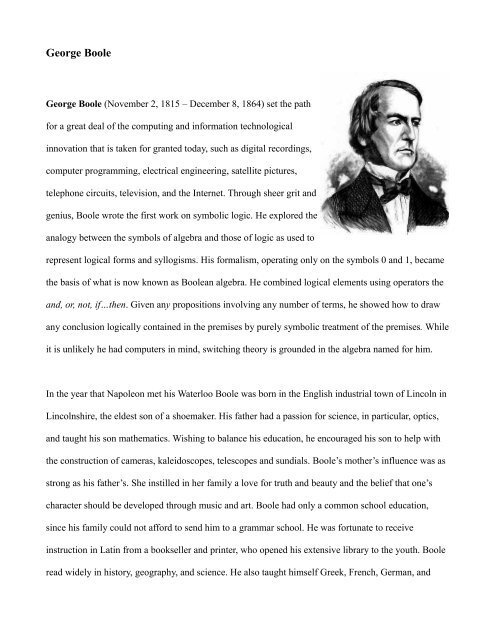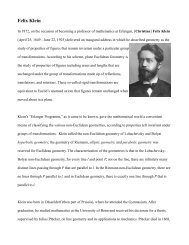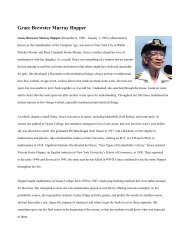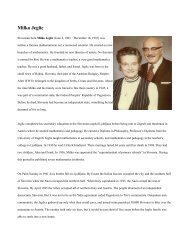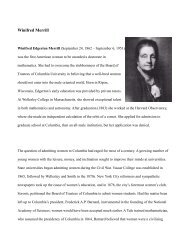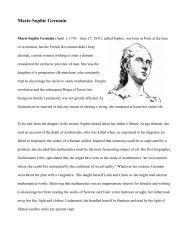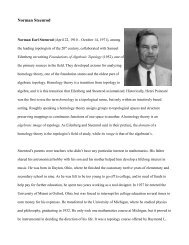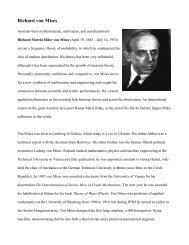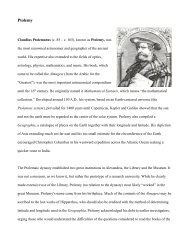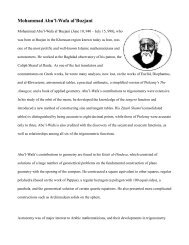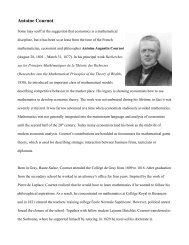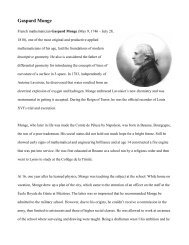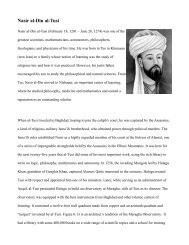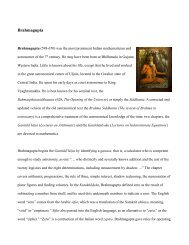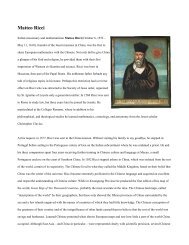George Boole
George Boole
George Boole
- No tags were found...
You also want an ePaper? Increase the reach of your titles
YUMPU automatically turns print PDFs into web optimized ePapers that Google loves.
<strong>George</strong> <strong>Boole</strong><strong>George</strong> <strong>Boole</strong> (November 2, 1815 – December 8, 1864) set the pathfor a great deal of the computing and information technologicalinnovation that is taken for granted today, such as digital recordings,computer programming, electrical engineering, satellite pictures,telephone circuits, television, and the Internet. Through sheer grit andgenius, <strong>Boole</strong> wrote the first work on symbolic logic. He explored theanalogy between the symbols of algebra and those of logic as used torepresent logical forms and syllogisms. His formalism, operating only on the symbols 0 and 1, becamethe basis of what is now known as <strong>Boole</strong>an algebra. He combined logical elements using operators theand, or, not, if…then. Given any propositions involving any number of terms, he showed how to drawany conclusion logically contained in the premises by purely symbolic treatment of the premises. Whileit is unlikely he had computers in mind, switching theory is grounded in the algebra named for him.In the year that Napoleon met his Waterloo <strong>Boole</strong> was born in the English industrial town of Lincoln inLincolnshire, the eldest son of a shoemaker. His father had a passion for science, in particular, optics,and taught his son mathematics. Wishing to balance his education, he encouraged his son to help withthe construction of cameras, kaleidoscopes, telescopes and sundials. <strong>Boole</strong>’s mother’s influence was asstrong as his father’s. She instilled in her family a love for truth and beauty and the belief that one’scharacter should be developed through music and art. <strong>Boole</strong> had only a common school education,since his family could not afford to send him to a grammar school. He was fortunate to receiveinstruction in Latin from a bookseller and printer, who opened his extensive library to the youth. <strong>Boole</strong>read widely in history, geography, and science. He also taught himself Greek, French, German, and
Italian, and that allowed him to read Continental scientific publications before they appeared in Englishtranslations.<strong>Boole</strong> never studied for a university degree. Instead, at the age of 16, he became an assistantschoolteacher. Dissatisfied with the low wages, he looked for another profession. As he could notafford the Army or Law, he decided to study to become an Episcopal priest, but after four years ofpreparation for the clergy, his parents persuaded him to return to teaching. At the age of twenty, heopened his own elementary school for young boys and girls, where, stimulated by this experience, hedeveloped his educational theories and published an essay on education. Finding that he needed to learnmore mathematics, he mastered the work of Newton, Laplace and Lagrange. This study resulted in hisfirst mathematical publication “Researches on the Theory of Analytical Transformations” (1838). In1844 The Royal Society awarded him a gold medal for a paper he wrote on the calculus of operators.<strong>Boole</strong> became friendly with Augustus De Morgan and took an interest in the DeMorgan’s controversyover logic with the Scottish philosopher Sir William Hamilton, (not to be confused with Irishmathematician Sir William Rowan Hamilton). As a result, <strong>Boole</strong> published The Mathematical Analysisof Logic (1847), which firmly established his reputation as a mathematician. In this work <strong>Boole</strong> firstintroduced his ideas of symbolic logic and demonstrated that logic, as presented by Aristotle, could berendered in the form of algebraic equations.In 1849 <strong>Boole</strong> was appointed professor of mathematics at Queen’s College in Cork, Ireland. Five yearslater he published his most famous work, An Investigation of the Laws of Thought on which arefounded the Mathematical Theories of Logic and Probabilities, which contained the concepts that nowconstitute <strong>Boole</strong>an algebra. He held that any consistent symbolic logical system was a part ofmathematics, and that the rules of logic were to be constructed not from ordinary language, but ratherfrom purely formal elements. In 1860 he published a book on the calculus of finite differences that
emains a standard work on the subject. <strong>Boole</strong> was very popular with his students and colleagues, buthe often became so engrossed in his thoughts that he was completely unaware of anything happeningaround him. Once his class arrived for his lecture, only to find him deep in thought. After waiting forsome time, they all quietly left. He never saw them come in or leave, and later concluded that the entireclass had been absent. One of his students recalled that when <strong>Boole</strong> was lecturing, “He looked, not likea professor writing a demonstration on a blackboard, but like an artist painting from a vision.” <strong>Boole</strong>suffered from eye disease and a hereditary lung problem, aggravated by the damp Irish climate. OnNovember 24, 1864, he walked two miles from his home to the College in a heavy rain. Soaked, helectured in his wet clothes, caught a cold, and after several weeks of fighting a lung infection, died ofpneumonia at age 49.<strong>Boole</strong>’s students and colleagues walked in his funeral procession through the town in full academicregalia. There is a memorial window honoring <strong>Boole</strong> located at the east end of the Aula Maxima (GreatHall) of the College (now named University College Cork). It consists of figures of Archimedes,Leonardo da Vinci, Copernicus, Hipparchus, Galileo, Bacon, Napier, Newton, Pascal, Leibniz,Descartes, Strabo, and Ptolemy surrounding a central panel of Euclid and Aristotle seated at his writingdesk. The <strong>Boole</strong> Library opened in 1983 and near by is the <strong>Boole</strong> Lecture Hall. <strong>Boole</strong>’s friends inLincoln collected funds to pay for a large stained-glass window to honor him. Known as the “TeachingWindow” it is located in the Cathedral Church of Lincoln. The central medallion depicts Christ with theteachers in the temple. The story of “the calling of Samuel,” one of <strong>Boole</strong>’s favorite passages in theBible is depicted in the lower medallion and Christ teaching “Render to Caesar” appear at the top.Beneath the window is a brass plaque:“In memory of <strong>George</strong> <strong>Boole</strong>, Dr. of Laws, of Lincoln. A man of acutest intellect and manifoldlearning, who, being specially exercised in the severer sciences, diligently explored the
ecesses of mathematics and happily illuminated them by his writings. He was carried off byan untimely death in 1864.”In 1855 <strong>Boole</strong> married Mary Everest, a brilliant woman, quite talented in mathematics. She was thedaughter of a minister Dr. Thomas R. Everest and his wife, Mary Ryall, and the niece of Sir<strong>George</strong> Everest, surveyor-general of India, after whom Mt. Everest is named. She was 18 when she met<strong>George</strong> <strong>Boole</strong>, then twice her age, who became her mathematics tutor. Mary <strong>Boole</strong> outlived herhusband by 52 years. After her husband’s death, she taught mathematics to future governesses in thewomen’s section of Queens College. Of their five daughters, their eldest, Mary Ellen, taught in Japan atthe turn of the century and married a mathematician and writer of science, who took a second wife andwas tried for bigamy before fleeing the country. Margaret was an artist, while Alicia (called Alice)developed an amazing skill with four-dimensional geometry. She introduced the term polytopes todescribe a four dimensional convex solid. She found that there were exactly six regular polytopesbounded by 5, 16 or 600 tetrahedra, 8 cubes, 24 octahedra or 120 dodecahedra. Daughter Lucy was thefirst female professor to head the chemistry department of Royal Free Hospital, London. The youngest,Ethel became a writer and translator and married the revolutionary, Wilfryd Michal Woynicz.Quotation of the Day: “No matter how correct a mathematical theorem may appear to be, oneought never to be satisfied that there was not something imperfect about it until it also gives theimpression of being beautiful.” – <strong>George</strong> <strong>Boole</strong>


